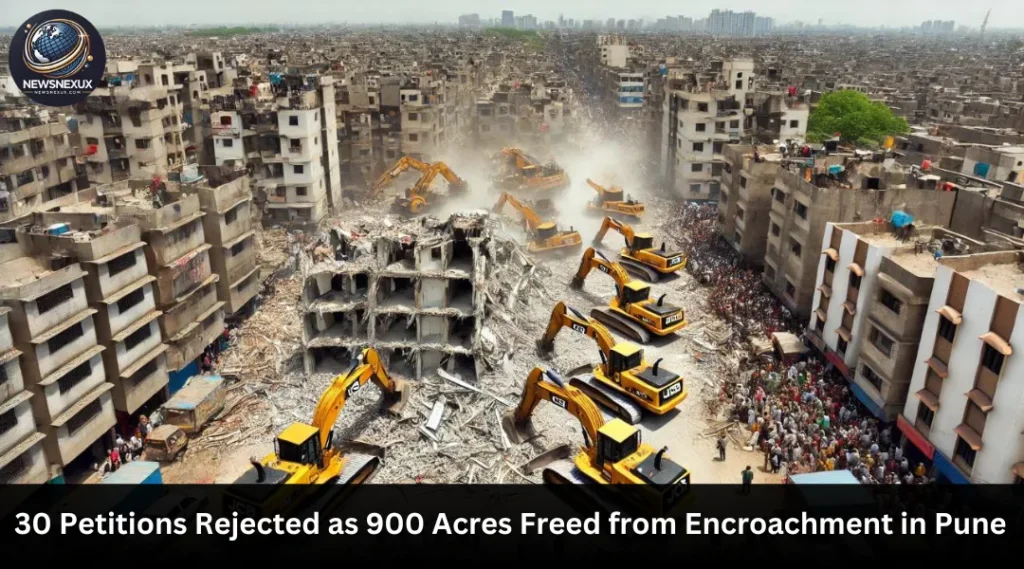
A massive anti-encroachment drive was recently carried out in Pune’s Pimpri Chinchwad area, marking the biggest bulldozer action in India’s history. In this operation, 900 acres of land were reclaimed from alleged Bangladeshi and Rohingya intruders. The authorities demolished over 5000 illegal structures, including mazars, junk shops, and factories, in an effort to clear unauthorized settlements. This large-scale eviction highlights the government’s intensified efforts to curb illegal land occupation and restore law and order in the region.
The crackdown faced strong opposition, with 30 petitions filed in the High Court to stop the action. However, all petitions were dismissed, reinforcing the government’s stand against encroachments. The incident has sparked widespread debate, raising questions about how such vast illegal settlements were established in the first place. Many argue that political backing and administrative negligence allowed encroachers to occupy the land for years without intervention. The demolition drive is now being seen as a turning point in the government’s strict approach to handling unauthorized settlements across India.
HUGE 🚨 BIGGEST Bulldozer action in the history of Independent India 🔥🔥
— Times Algebra (@TimesAlgebraIND) February 27, 2025
900 acres of land was cleared from Bangladeshi and Rohingya infiltrators in Pimpri Chinchwad area of Pune.
5000 Illegal mazaars, scrap shops, and factories razed in Pune’s mega anti-encroachment drive.… pic.twitter.com/uf9d4XlIoJ
Meanwhile, tensions remain high in Maharashtra, particularly in Sindhudurg, where a separate controversy emerged during an India-Pakistan cricket match. Reports claim that a local individual expressed support for Pakistan after Indian cricketer Rohit Sharma was dismissed, leading to public outrage. These incidents reflect the broader political and social narratives in the state, where issues of illegal immigration, national security, and political alignments continue to dominate public discourse. The BJP-led government has reinforced its commitment to tackling illegal settlements, sending a strong message against encroachment and unauthorized occupation across NDA-ruled states.
What is Happening in Maharashtra?
Recently, Maharashtra has been in the news due to a large-scale anti-encroachment drive. In Pune’s Pimpri Chinchwad area, the state government conducted a massive bulldozer action, clearing 900 acres of land that were allegedly encroached upon by illegal Bangladeshi and Rohingya immigrants. More than 5000 illegal structures, including mazars, junk shops, and factories, were demolished. Despite multiple petitions being filed in the High Court to stop the operation, all were rejected, leading to one of the largest such drives in India’s history. This move is being seen as part of a broader effort by the government to regulate land ownership and curb illegal settlements.
Religious Harmony and Contributions of Muslims in India
Muslims in India contribute significantly to various fields, including politics, business, sports, entertainment, and education. Prominent leaders, scholars, and industrialists from the Muslim community have played a vital role in shaping modern India.
Common Misconceptions About the Muslim Population in India
Some misconceptions exist regarding the growth and influence of the Muslim population in India. While the community has seen growth, data indicates that the overall fertility rate among Muslims is declining. The fears of Muslims becoming a majority in India are unfounded, as demographic experts estimate that the Hindu population will remain the majority for the foreseeable future.
Future Projections
Experts estimate that by 2050, India’s Muslim population will grow to around 310 million, still maintaining a significant but stable percentage of the total population.
Frequently Asked Questions (FAQs)
1. What is the current population of Muslims in India?
As of 2025, the estimated Muslim population in India is around 200 million, making up approximately 15% of the total population.
2. Which Indian state has the highest Muslim population?
Uttar Pradesh has the largest Muslim population, with over 38 million Muslims.
3. What percentage of India’s population is Muslim?
Muslims constitute around 15% of India’s total population as of 2025.
4. Is the Muslim population growing faster than other religions in India?
While the Muslim population has historically had a higher growth rate, recent trends show a decline in fertility rates, making the growth rate closer to that of other communities.
5. Will Muslims become the majority in India?
No, demographic studies show that Hindus will continue to be the majority in India for the foreseeable future.
6. How does India compare to other countries in terms of Muslim population?
India has the third-largest Muslim population in the world, after Indonesia and Pakistan.
7. How has the Muslim population changed over the years?
Between 2001 and 2011, the Muslim population grew by 24.6%. However, current trends indicate a slowdown in growth.
8. Are there any specific cities with a large Muslim population?
Yes, cities like Delhi, Mumbai, Kolkata, Hyderabad, Lucknow, and Aligarh have significant Muslim populations.
9. What role do Muslims play in India’s economy?
Muslims contribute significantly to business, politics, entertainment, sports, and technology, making them an integral part of India’s progress.
10. What is the literacy rate among Muslims in India?
According to the 2011 Census, the literacy rate among Muslims was around 68.5%, which has been improving with better educational initiatives.
Conclusion
The Muslim population in India is an essential part of the country’s social fabric. While their numbers are substantial, growth trends indicate stabilization, debunking many myths regarding religious demographics. With increasing educational opportunities and economic contributions, Indian Muslims continue to play a significant role in shaping the nation’s future.
